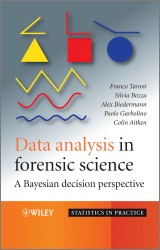Details

Data Analysis in Forensic Science
A Bayesian Decision PerspectiveStatistics in Practice, Band 88 1. Aufl.
|
79,99 € |
|
| Verlag: | Wiley |
| Format: | |
| Veröffentl.: | 19.03.2010 |
| ISBN/EAN: | 9780470665077 |
| Sprache: | englisch |
| Anzahl Seiten: | 392 |
DRM-geschütztes eBook, Sie benötigen z.B. Adobe Digital Editions und eine Adobe ID zum Lesen.
Beschreibungen
This is the first text to examine the use of statistical methods in forensic science and bayesian statistics in combination. <p>The book is split into two parts: Part One concentrates on the philosophies of statistical inference. Chapter One examines the differences between the frequentist, the likelihood and the Bayesian perspectives, before Chapter Two explores the Bayesian decision-theoretic perspective further, and looks at the benefits it carries.</p> <p>Part Two then introduces the reader to the practical aspects involved: the application, interpretation, summary and presentation of data analyses are all examined from a Bayesian decision-theoretic perspective. A wide range of statistical methods, essential in the analysis of forensic scientific data is explored. These include the comparison of allele proportions in populations, the comparison of means, the choice of sampling size, and the discrimination of items of evidence of unknown origin into predefined populations.</p> <p>Throughout this practical appraisal there are a wide variety of examples taken from the routine work of forensic scientists. These applications are demonstrated in the ever-more popular R language. The reader is taken through these applied examples in a step-by-step approach, discussing the methods at each stage.</p>
Foreword. <p>Preface.</p> <p><b>I The Foundations of Inference and Decision in Forensic Science</b>.</p> <p><b>1 Introduction</b>.</p> <p>1.1 The Inevitability of Uncertainty.</p> <p>1.2 Desiderata in Evidential Assessment.</p> <p>1.3 The Importance of the Propositional Framework and the Nature of Evidential Assessment.</p> <p>1.4 From Desiderata to Applications.</p> <p>1.5 The Bayesian Core of Forensic Science.</p> <p>1.6 Structure of the Book.</p> <p><b>2 Scientific Reasoning and Decision Making.</b></p> <p>2.1 Coherent Reasoning Under Uncertainty.</p> <p>2.2 Coherent Decision Making Under Uncertainty of Reasoning.</p> <p>2.3 Scientific Reasoning as Coherent Decision Making.</p> <p>2.4 Forensic Reasoning as Coherent Decision Making.</p> <p><b>3 Concepts of Statistical Science and Decision Theory.</b></p> <p>3.1 Random Variables and Distribution Functions.</p> <p>3.2 Statistical Inference and Decision Theory.</p> <p>3.3 The Bayesian Paradigm.</p> <p>3.4 Bayesian Decision Theory.</p> <p>3.5 R Code.</p> <p><b>II Forensic Data Analysis.</b></p> <p><b>4 Point Estimation.</b></p> <p>4.1 Introduction.</p> <p>4.2 Bayesian Decision for a Proportion.</p> <p>4.3 Bayesian Decision for a Poisson Mean.</p> <p>4.4 Bayesian Decision for Normal Mean.</p> <p>4.5 R Code.</p> <p><b>5 Credible Intervals.</b></p> <p>5.1 Introduction.</p> <p>5.2 Credible Intervals.</p> <p>5.3 Decision-Theoretic Evaluation of Credible Intervals.</p> <p>5.4 R Code.</p> <p><b>6 Hypothesis Testing.</b></p> <p>6.1 Introduction.</p> <p>6.2 Bayesian Hypothesis Testing.</p> <p>6.3 One-sided testing.</p> <p>6.4 Two-Sided Testing.</p> <p>6.5 R Code.</p> <p><b>7 Sampling.</b></p> <p>7.1 Introduction.</p> <p>7.2 Sampling Inspection.</p> <p>7.3 Graphical Models for Sampling Inspection.</p> <p>7.4 Sampling Inspection under a Decision-Theoretic Approach.</p> <p>7.5 R Code.</p> <p><b>8 Classification of Observations.</b></p> <p>8.1 Introduction.</p> <p>8.2 Standards of Coherent Classification.</p> <p>8.3 Comparing Models using Discrete Data.</p> <p>8.4 Comparison of Models using Continuous Data.</p> <p>8.5 Non-Normal Distributions and Cocaine on Bank Notes.</p> <p>8.6 A note on Multivariate Continuous Data.</p> <p>8.7 R Code.</p> <p><b>9 Bayesian Forensic Data Analysis: Conclusions and Implications.</b></p> <p>9.1 Introduction.</p> <p>9.2 What is the Past and Current Position of Statistics in Forensic Science?</p> <p>9.3 Why Should Forensic Scientists Conform to a Bayesian Framework for Inference and Decision Making?</p> <p>9.4 Why Regard Probability as a Personal Degree of Belief?</p> <p>9.5 Why Should Scientists be Aware of Decision Analysis?</p> <p>9.6 How to Implement Bayesian Inference and Decision Analysis?</p> <p><b>A Discrete Distributions.</b></p> <p><b>B Continuous Distributions.</b></p> <p>Bibliography.</p> <p>Author Index.</p> <p>Subject Index.</p>
<p><strong>Franco Taroni</strong>, Institute de Police Scientifique et de Criminologie, University of Lausanne, Switzerland. <p><strong>Silvia Bozza</strong>, Departimento di Statistica, Universit`a di Venezia, Italy. <p><strong>Alex Biedermann</strong>, Bundeskriminalpolizei, Kommissariat Kriminaltechnik, Switzerland. <p><strong>Paolo Garbolino</strong>, Faculty of Arts and Design, IUAV University, Venice, Italy. <p><strong>Colin Aitken</strong>, School of Mathematics, University of Edinburgh, UK.
The use of formal statistical methods to analyse quantitative data in forensic science has increased considerably over the last few years. Students, researchers and practitioners in forensic science regularly ask questions concerning the relative merits of differing approaches, in particular the frequentist and Bayesian approaches, to statistical inference in the forensic context. The ideas of the Bayesian approach in forensic science are now being extended to include decision theory and the associated concept of utility. <p><i>Data Analysis in Forensic Science: A Bayesian Decision Perspective</i> sets forth procedures for data analysis that rely on the decision-theoretic approach to inference. Emphasis is made on foundational philosophical tenets as well as the implications of the decision-theoretic approach in practice. This book discusses a range of statistical decision-theoretic methods that are useful in the analysis of forensic scientific data. Forensic scientific examples include point estimation, the comparison of means and proportions in populations, the choice of sample size and the classification of items of evidence of unknown origin into predefined populations.</p> <p>Key Features:</p> <ul type="disc"> <li>Comprehensive coverage of the analysis of forensic data from a Bayesian perspective, featuring numerous real-world examples and applications.</li> <li>Explanation and definition of key concepts and methods from historical, philosophical and theoretical points of view.</li> <li>An incremental approach for consideration of examples inspired and motivated by issues that may arise in routine forensic practice.</li> <li>Consideration of the arguments and methods, including those of decision theory, used at each stage of the analyses.</li> <li>Inclusion of code written in R to offer an opportunity for enhanced exploration of the ideas.</li> <li>The use of graphical models (e.g. Bayesian networks) to illustrate selected applications of Bayesian methodology.</li> </ul>
Diese Produkte könnten Sie auch interessieren:

Nonparametric Regression Methods for Longitudinal Data Analysis

von: Hulin Wu, Jin-Ting Zhang

135,99 €

Statistics and the Evaluation of Evidence for Forensic Scientists

von: Colin Aitken, Franco Taroni

103,99 €














